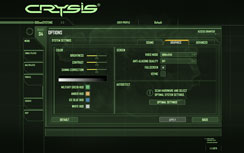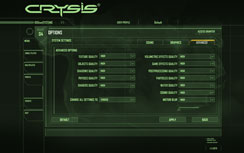MSI N260GTX Lightning Review
Written by Mark Mackay
July 6, 2009 | 10:15
Tags: #55nm #geforce #gtx-260 #lightning #maxcore #n260gtx #overclockable #review

Crysis
Publisher: Electronic ArtsCrysis is seen by many as the poster boy for DirectX 10 and it will make your system cry, quite literally – it’s a monster! It doesn’t come as much of a surprise then, that the graphics are something special – they’re above and beyond anything we’ve ever seen in a PC game.
We tested the game using the 64-bit executable under DirectX 10 mode with the 1.21 patch applied. We used a custom timedemo recorded from the Laws of Nature level which is more representative of gameplay than the built-in benchmark that renders things much faster than you're going to experience in game. We found that around 27-33 fps in our custom timedemo was sufficient enough to obtain a playable frame rate through the game. It's a little different to other games in that the low frame rates still appear to be quite smooth.
We set all of the in-game details to High and forced 8x anisotropic filtering in the driver menu as there is currently no support for it in game. We tested at 1,280 x 1,024, using 0x, 2x and 4x anti-aliasing, 1,680 x 1,050 using 0x and 4xAA, 1,920 x 1,200 using 0x and 2xAA and 2,560 x 1,600 with 0xAA and 2xAA. By extensively testing using anti-aliasing in very high resolutions in conjunction to Very High quality, we'll be pushing even the bleeding edge hardware on test to the limit.
Crysis
1,280 x 1,024 0xAA 16xAF, DirectX 10, High Quality
- ATI Radeon HD 4870 X2 2GB
- Nvidia GeForce GTX 285 1GB
- Nvidia GeForce GTX 275 896MB
- Sapphire Radeon HD 4890 1GB Atomic
- ATI Radeon HD 4890 1GB
- Asus Radeon HD 4890 1GB
- MSI N260GTX Lightning
- Nvidia GeForce GTX 260-216 896MB
-
-
59.5
-
34.0
-
-
-
56.7
-
33.0
-
-
-
52.6
-
31.0
-
-
-
51.1
-
28.0
-
-
-
44.9
-
24.0
-
-
-
44.9
-
24.0
-
-
-
36.7
-
21.0
-
-
-
35.8
-
19.0
-
0
10
20
30
40
50
60
Frames Per Second
-
Average
-
Minimum
Crysis
1,280 x 1,024 4xAA 16xAF, DirectX 10, High Quality
- ATI Radeon HD 4870 X2 2GB
- Nvidia GeForce GTX 285 1GB
- Nvidia GeForce GTX 275 896MB
- Sapphire Radeon HD 4890 1GB Atomic
- MSI N260GTX Lightning
- Nvidia GeForce GTX 260-216 896MB
- ATI Radeon HD 4890 1GB
- Asus Radeon HD 4890 1GB
-
-
53.1
-
29.0
-
-
-
49.2
-
29.0
-
-
-
45.4
-
27.0
-
-
-
42.4
-
22.0
-
-
-
42.1
-
25.0
-
-
-
42.1
-
25.0
-
-
-
38.1
-
19.0
-
-
-
38.1
-
19.0
-
0
10
20
30
40
50
Frames Per Second
-
Average
-
Minimum
Crysis
1,680 x 1,050 0xAA 16xAF, DirectX 10, High Quality
- ATI Radeon HD 4870 X2 2GB
- Nvidia GeForce GTX 285 1GB
- Nvidia GeForce GTX 275 896MB
- Sapphire Radeon HD 4890 1GB Atomic
- Asus Radeon HD 4890 1GB
- ATI Radeon HD 4890 1GB
- MSI N260GTX Lightning
- Nvidia GeForce GTX 260-216 896MB
-
-
51.4
-
30.0
-
-
-
46.4
-
29.0
-
-
-
43.4
-
26.0
-
-
-
41.3
-
23.0
-
-
-
36.3
-
20.0
-
-
-
36.3
-
20.0
-
-
-
29.3
-
17.0
-
-
-
28.9
-
16.0
-
0
10
20
30
40
50
Frames Per Second
-
Average
-
Minimum
Crysis
1,680 x 1,050 4xAA 16xAF, DirectX 10, High Quality
- ATI Radeon HD 4870 X2 2GB
- Nvidia GeForce GTX 285 1GB
- Nvidia GeForce GTX 275 896MB
- Sapphire Radeon HD 4890 1GB Atomic
- Asus Radeon HD 4890 1GB
- ATI Radeon HD 4890 1GB
- MSI N260GTX Lightning
- Nvidia GeForce GTX 260-216 896MB
-
-
44.0
-
25.0
-
-
-
39.7
-
24.0
-
-
-
36.9
-
23.0
-
-
-
34.5
-
19.0
-
-
-
31.0
-
17.0
-
-
-
31.0
-
17.0
-
-
-
24.6
-
14.0
-
-
-
24.6
-
14.0
-
0
10
20
30
40
Frames Per Second
-
Average
-
Minimum
Crysis
1,920 x 1,200 0xAA 16xAF, DirectX 10, High Quality
- ATI Radeon HD 4870 X2 2GB
- Nvidia GeForce GTX 285 1GB
- Sapphire Radeon HD 4890 1GB Atomic
- Nvidia GeForce GTX 275 896MB
- MSI N260GTX Lightning
- Nvidia GeForce GTX 260-216 896MB
- Asus Radeon HD 4890 1GB
- ATI Radeon HD 4890 1GB
-
-
47.0
-
28.0
-
-
-
38.4
-
23.0
-
-
-
37.0
-
21.0
-
-
-
36.0
-
22.0
-
-
-
33.3
-
19.0
-
-
-
32.8
-
18.0
-
-
-
32.6
-
19.0
-
-
-
32.6
-
19.0
-
0
10
20
30
40
50
Frames Per Second
-
Average
-
Minimum
Crysis
1,920 x 1,200 2xAA 16xAF, DirectX 10, High Quality
- ATI Radeon HD 4870 X2 2GB
- Nvidia GeForce GTX 285 1GB
- Sapphire Radeon HD 4890 1GB Atomic
- Nvidia GeForce GTX 275 896MB
- Asus Radeon HD 4890 1GB
- ATI Radeon HD 4890 1GB
- MSI N260GTX Lightning
- Nvidia GeForce GTX 260-216 896MB
-
-
44.1
-
27.0
-
-
-
35.0
-
21.0
-
-
-
34.0
-
20.0
-
-
-
32.1
-
20.0
-
-
-
30.3
-
18.0
-
-
-
30.3
-
18.0
-
-
-
29.8
-
18.0
-
-
-
29.2
-
17.0
-
0
10
20
30
40
Frames Per Second
-
Average
-
Minimum
Crysis
2,560 x 1,600 0xAA 16xAF, DirectX 10, High Quality
- ATI Radeon HD 4870 X2 2GB
- Nvidia GeForce GTX 285 1GB
- Sapphire Radeon HD 4890 1GB Atomic
- Nvidia GeForce GTX 275 896MB
- MSI N260GTX Lightning
- Nvidia GeForce GTX 260-216 896MB
- ATI Radeon HD 4890 1GB
- Asus Radeon HD 4890 1GB
-
-
30.1
-
17.0
-
-
-
23.1
-
13.0
-
-
-
22.2
-
12.0
-
-
-
22.1
-
12.0
-
-
-
20.2
-
10.0
-
-
-
19.9
-
10.0
-
-
-
19.6
-
10.0
-
-
-
19.6
-
10.0
-
0
5
10
15
20
25
30
Frames Per Second
-
Average
-
Minimum
In the majority of Crysis tests, the Lightning was only capable of beating a stock speed GTX 260, with the two cards loitering down the bottom of the graphs. At 1,280 x 1,024 with 4xAA it did better, but was still slower than the cheaper GTX 275 which managed a couple of frames per second faster minimum frame rate which is especially important around the 25fps mark as when it drops below this you start to notice slowdown.











Want to comment? Please log in.